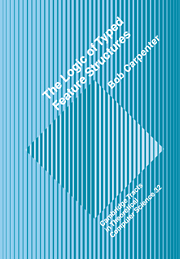 The Logic of Typed Feature Structures
The Logic of Typed Feature Structures Published online by Cambridge University Press: 12 October 2009
In this chapter we introduce the logical attribute-value language that we employ to describe feature structures. Our description language is the same (in the sense of containing exactly the same descriptions) as that of Rounds and Kasper (1986), but following Pollard (in press) our interpretations are based on our feature structures rather than the ones provided by Rounds and Kasper. One way to look at the language of descriptions is as providing a way to talk about feature structures; the language can be displayed linearly one symbol after another and can thus be easily used in implementations. Other researchers, namely Johnson (1987, 1988), Smolka (1988) and King (1989), use similar, but much more powerful, logical description languages and take a totally different view of the nature of interpretations or models for these languages. The main difference in their descriptions is the presence of general description negation, implication, and variables. The interpretations they use are based on a domain of objects with features interpreted as unary partial functions on this domain. In the system we describe here, we view feature structures themselves as partial objects; descriptions are just a particularly neat and tidy notation for picking them out. Our view thus corresponds to Aït-Kaci's treatment of his ψ-terms, which were also taken to be partial descriptions of empirical objects. Johnson (1988:72), on the other hand, is at pains to point out that he does not view feature structures as partial models or descriptions of total linguistic objects, but rather as total objects themselves.
To save this book to your Kindle, first ensure [email protected] is added to your Approved Personal Document E-mail List under your Personal Document Settings on the Manage Your Content and Devices page of your Amazon account. Then enter the ‘name’ part of your Kindle email address below. Find out more about saving to your Kindle.
Note you can select to save to either the @free.kindle.com or @kindle.com variations. ‘@free.kindle.com’ emails are free but can only be saved to your device when it is connected to wi-fi. ‘@kindle.com’ emails can be delivered even when you are not connected to wi-fi, but note that service fees apply.
Find out more about the Kindle Personal Document Service.
To save content items to your account, please confirm that you agree to abide by our usage policies. If this is the first time you use this feature, you will be asked to authorise Cambridge Core to connect with your account. Find out more about saving content to Dropbox.
To save content items to your account, please confirm that you agree to abide by our usage policies. If this is the first time you use this feature, you will be asked to authorise Cambridge Core to connect with your account. Find out more about saving content to Google Drive.